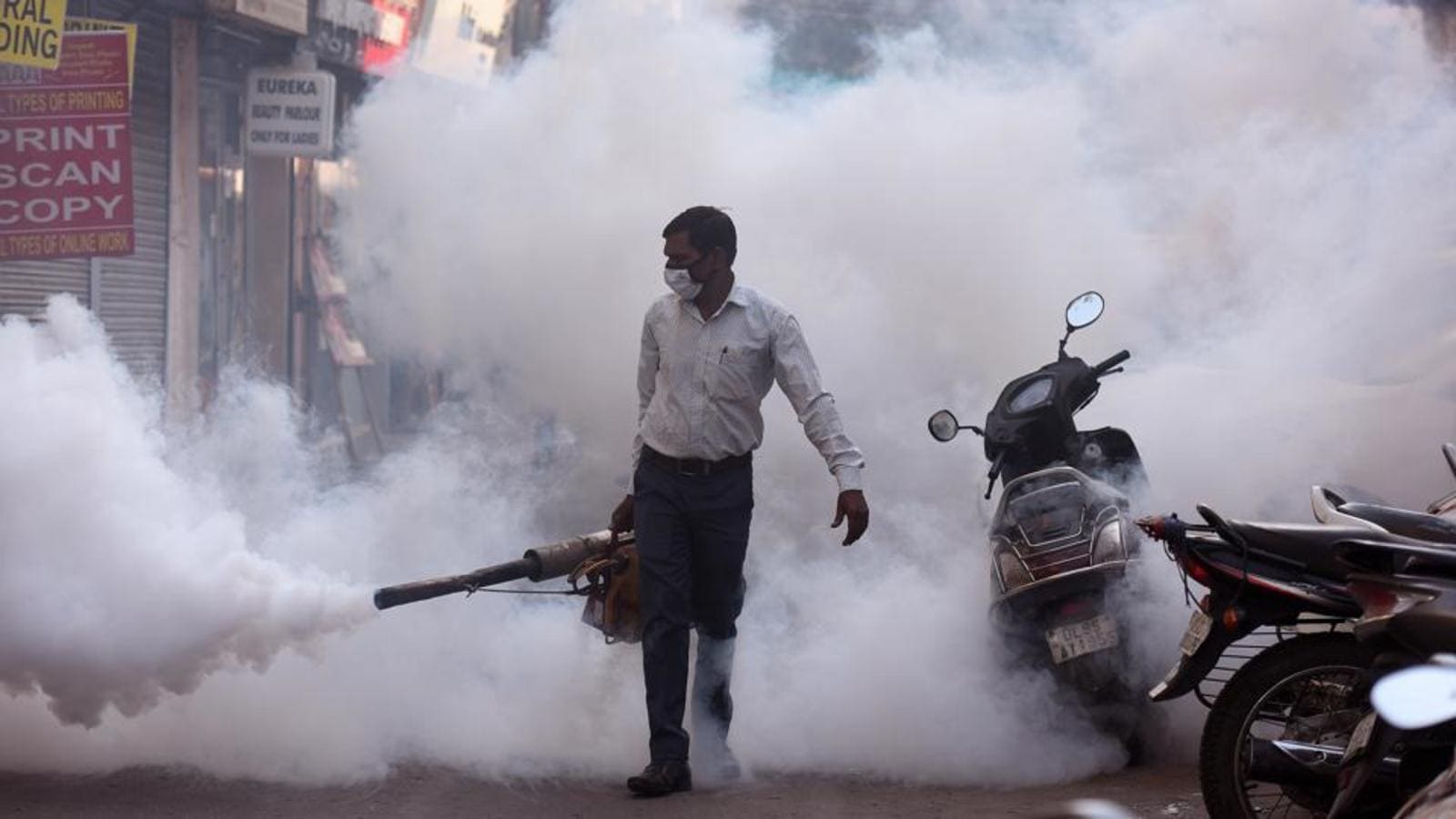Delhi reported the highest number of dengue cases this year since the 2015 outbreak. The infection rate has been ebbing over the last week or so. While a prolonged monsoon was blamed for aiding mosquito breeding that spread the disease, the dipping temperature is being credited for the drop in numbers.
Rainfall, humidity and temperature determine dengue transmission dynamics not just in Delhi but all across the world where the disease is endemic. In Delhi, the disease that has become synonymous with a recurring public health crisis is also due to non-climatic factors such as community inaction, inadequate prevention mechanisms, missing civic amenities and chaotic urbanisation. Simply put, it is a problem deeply embedded in the way we build, run and live in the city.
An improved structure for reporting
This year though, the administration took steps to institutionally recognise the crisis and give more teeth to the enforcement mechanism.
Last month, a regulation to make vector-borne diseases such as dengue, malaria and chikungunya notifiable diseases under the Epidemic Disease Act made it mandatory for all hospitals and clinics to report these cases to the government. Affected and contiguous neighbourhoods, where there is a danger of an outbreak, will have to be declared “infected” or “threatened” areas with focused vector-control measures put in place.
An individual or institution violating instructions (such as not following mosquito breeding control measures or not reporting cases) is to be prosecuted under section 188 of the Indian Penal Code, the notification states. This entails up to six months imprisonment and ₹1,000 fine or both.
Till now, official records didn’t always give the complete picture as reporting of dengue cases was low, and multiple authorities used to bicker over jurisdiction and the domicile status of patients. Most residents would resist door-to-door inspection to check the breeding of Aedes aegypti, a mosquito that breeds in clean water and carries and transmits the dengue virus. The residents would then complain of harassment when fined (up to R500) for violation. Whether the new norms change that or not will depend on how sincerely the rules are enforced, and how far the citizens cooperate.
At the very least, the new regulations should help quantify the burden of the disease. In the coming years, better reporting will translate into a spike in dengue cases. But instead of getting alarmed and indulging in blame games, authorities must focus on how to make the most of this data in getting a more realistic measure of the challenge and mobilising adequate resources to meet it.
In fact, the new regulation directs authorities to use this data to draw up action plans in active disease clusters, and scale-up testing, surveillance, enforcement and public health infrastructure accordingly. It should also serve as a wake-up call for citizens who often underestimate the dengue menace and continue with their lax ways.
“With mandatory reporting of dengue cases, monitoring prevalent trends and vector-control strategies becomes easier. We also have a way to figure out if those measures have been beneficial or they need to be re-strategised,” said Dr Sanjay Rai, professor at the Centre for Community Medicine at All India Institute of Medical Sciences (AIIMS).
Lessons from Singapore
Singapore, which also struggles with the outbreak of vector-borne diseases, has made community-based initiatives its key prevention strategy. In 2013, the city-state started the Mozzie Wipeout campaign and even has a colour-coded alert system.
While the red alert indicates that there are more than 10 cases in a neighbourhood, the yellow alert means two to nine cases. The green code implies there are none and thanks citizens for their efforts. The alert prescribes BLOCK strategy — break up the hardened soil; lift and empty flower pot plates; overturn pails and wipe their rims; change the water in vases; and keep roof gutters clear and place insecticide — as vector-control measures.
Besides, there are specific warnings such as one issued this April when residents were asked to pay extra attention to their compounds as a higher incidence of Aedes breeding was found there as compared to high-rise apartments. Also, through a visual campaign, the government provides a do-it-yourself (DIY) manual for homes, even listing out a to-do list on how to prevent mosquito breeding in homes that remain locked when owners travel.
Delhi’s new notification states that all new buildings in the national capital will have to obtain an occupancy certificate from the public health department. A precondition to get this certificate is that owners and builders put in place permanent measures to prevent mosquito breeding on their premises. The municipalities say that are in the process of formulating standardised norms, which are likely to include a prescribed minimum slope on roofs so water doesn’t stagnate, proper mosquito-proof covers for overhead tanks, a minimum number of outlets to drain out rainwater, HT reported on November 12.
Singapore too made small interventions in its public housing to control mosquito breeding. In high-rise apartments, for instance, clothes used to be hung out to dry on bamboo poles fixed into tube-shaped pole holders on the side of the building. When Aedes larvae were detected here in large numbers, the authorities made it mandatory to put caps to cover these holders. Soon, holders were replaced with brackets that held the poles. Also, anti-mosquito valves that allow water to drain away are installed in gully drains in high-rises. These buildings are constructed without roof gutters, which are difficult to access and clean because of their height, research on Singapore dengue control programme published in PLOS Neglected Tropical Diseases in 2020 stated.
Sustaining the effort
For public messaging, the Delhi government in 2019 launched the 10 Hafte-10 Baje-10 Minute campaign where chief minister Arvind Kejriwal urges residents to spare 10 minutes at 10 am every Sunday for 10 consecutive weeks to check mosquito breeding in their homes and surroundings to prevent the spread of dengue and chikungunya.
The success of the initiative depends on how well the campaign is sustained in the long term by the government and Delhi’s residents through mutual trust and cooperation. Getting all stakeholders— individuals, resident welfare associations, the municipalities, government officials and elected representatives — on board is equally crucial.
Consistency, however, will remain the key. In spite of having one of the best prevention programmes in place and experimenting with initiatives such as releasing Wolbachia bacteria-infected mosquitoes to prevent transmission of the dengue virus, Singapore saw the highest number of cases in a single year in 2020.
This led to 20 recorded deaths by August 2, 2020, (the final toll for the year was 32) pushing the related case-fatality rate higher than the local impact of Covid‑19, reported The Economist Intelligence Unit on August 6, 2020. It said that prolonged lockdown during the pandemic made residents stay at home and come in contact with infected mosquitos. The suspension of construction work and quarantine of foreign workers in their dormitories affected sanitation, leading to mosquito breeding. Frequent rain worsened the situation.
Besides the lockdown measures, experts cited the return of an old strain of the dengue virus, which has not been around for nearly three decades, for the uptick in cases, CNN reported in July 2020.
Urban mess, scarce amenities
Dengue and other vector-borne diseases are also linked to the larger issues of quality of life, urbanisation and changing weather patterns.
As pointed out in the Metro Matters last month, erratic weather events including record-breaking, unseasonal rain and rising temperature have obvious consequences for health, and Delhi is already showing these symptoms. In 2010, for instance, when Delhi saw a prolonged monsoon, as many as 6,259 cases of dengue were recorded. This year again, record rainfall is being blamed for a spurt in infection, with the caseload crossing the 7,000-mark.
In their study of the social and environmental risk factors for dengue in Delhi, researchers from the CNRS, the Institut Pasteur and the National Institute of Malaria found that cases of dengue in winter (although not too many) were found in disadvantaged and densely populated neighbourhoods. In the absence of regular, piped water supply in their homes, residents here stored water in jars and other containers that turned out to be ideal breeding places for mosquitoes. The high density of population in these tightly-packed neighbourhoods creates heat islands with temperatures here reaching up to 15 degrees Celsius in January (10°C higher than in less densely populated areas), keeping the mosquitoes alive even in winter, the study stated.
The research published in PLOS Neglected Tropical Diseases this February also found that despite a lower mosquito infestation and adequate infrastructure, wealthy neighbourhoods in Delhi were almost as affected by dengue infection as the disadvantaged neighbourhoods. This, the study said, was because of daily intra-city travel of residents connecting the upscale and the underprivileged neighbourhoods.
In their recommendations, researchers stressed the need “to put health at the centre of urban planning and investment in access to tap water, which is the most fundamental of human rights”.
“Such basic access to tap water could not only reduce the burden of dengue but also epidemics caused by other water-related diseases such as cholera. The spread of disease recognises no socio-economic boundaries and eliminating sources of infection must be a priority, not only for the socially disadvantaged population but for the urban community as a whole,” they said.
While tropical and sub-tropical weather aids seasonal outbreaks of vector-borne infections, the disease burden can be reduced with disciplined urbanisation, provision of basic amenities, public participation and sustained prevention mechanisms. That’s the prescription for Delhi.
The views expressed are personal
Stay connected with us on social media platform for instant update click here to join our Twitter, & Facebook
We are now on Telegram. Click here to join our channel (@TechiUpdate) and stay updated with the latest Technology headlines.
For all the latest For News Update Click Here

